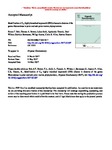Identification of C 25 highly branched isoprenoid (HBI) alkenes in diatoms of the genus Rhizosolenia in polar and sub-polar marine phytoplankton.
| dc.contributor.author | Belt, Simon | |
| dc.contributor.author | Brown, TA | |
| dc.contributor.author | Smik, L | |
| dc.contributor.author | Tatarek, A | |
| dc.contributor.author | Wiktor, J | |
| dc.contributor.author | Stowasser, G | |
| dc.contributor.author | Assmy, P | |
| dc.contributor.author | Allen, CS | |
| dc.contributor.author | Husum, K | |
| dc.date.accessioned | 2017-07-26T15:59:34Z | |
| dc.date.issued | 2017-08 | |
| dc.identifier.issn | 0146-6380 | |
| dc.identifier.uri | http://hdl.handle.net/10026.1/9642 | |
| dc.description.abstract |
We report the identification of a range of C25 highly branched isoprenoid (HBI) alkenes and certain sterols in filtered phytoplankton samples obtained from western Svalbard (Arctic) and near South Georgia (South Atlantic, sub-Antarctic) in 2016 and 2014, respectively. The C25 HBIs contained 3–5 double bonds and had structures identified previously from analysis of laboratory diatom cultures. The same HBIs were also identified in individual diatom taxa isolated from the mixed assemblages and with reasonably similar distributions. Thus, C25 HBIs were identified in Rhizosolenia setigera isolated from western Svalbard near-surface waters, while the same HBIs were also found in R. polydactyla f. polydactyla and R. hebetata f. semispina picked from seawater collected from a site in the South Atlantic. The main sterol composition was slightly different between the two locations, with cholesta-5,24-dien-3β-ol (desmosterol) identified as one of the major components in the sample from West Svalbard, consistent with the diatom assemblage being dominated by R. setigera. In contrast, the major sterol in the South Atlantic sample was cholesta-5,22-dien-3β-ol (22-dehydrocholesterol), likely reflecting the relatively high proportion of the genus Pseudo-nitzschia. For both locations, the suite of HBIs included a tri-unsaturated isomer (HBI III; 6Z-2,6,10,14-tetramethyl-9-(3′-methylpent-4-enylidene)-pentadec-6-ene), proposed in previous studies as a potential proxy measure of pelagic sea ice-edge conditions, and thus a counterpart to the mono- and di-unsaturated HBIs IP25 and IPSO25, which have been used as seasonal sea ice proxies in the Arctic and Antarctic, respectively. HBI III has been reported previously in sediments from West Svalbard and we report here its occurrence in a small number of surface sediments from the South Atlantic. For both regions, HBI III was present as one of the major HBIs in sediments, which contrasts with the HBI distributions in the filtered phytoplankton samples, where HBIs with four and five double bonds were the major components. Differences in HBI distributions between phytoplankton and sediment samples may potentially be due to the presence of other (unanalysed) diatoms in the filtered water samples, seasonal/annual variability in the production of HBIs by a range of diatoms, differential degradation of HBIs between sources and sediments, or a combination of these. Interestingly, we did not detect any C30 HBIs in the water samples, picked cells or sediments from either location, despite earlier reports of these lipids in laboratory cultures of R. setigera. This study represents the first source identification of certain C25 HBI lipids under in situ pelagic conditions. | |
| dc.format.extent | 65-72 | |
| dc.language | en | |
| dc.language.iso | en | |
| dc.publisher | Elsevier BV | |
| dc.subject | Highly branched isoprenoid | |
| dc.subject | Alkene | |
| dc.subject | Diatom | |
| dc.subject | Biomarker | |
| dc.subject | Rhizosolenia | |
| dc.title | Identification of C 25 highly branched isoprenoid (HBI) alkenes in diatoms of the genus Rhizosolenia in polar and sub-polar marine phytoplankton. | |
| dc.type | journal-article | |
| dc.type | Journal Article | |
| plymouth.author-url | https://www.webofscience.com/api/gateway?GWVersion=2&SrcApp=PARTNER_APP&SrcAuth=LinksAMR&KeyUT=WOS:000405995000009&DestLinkType=FullRecord&DestApp=ALL_WOS&UsrCustomerID=11bb513d99f797142bcfeffcc58ea008 | |
| plymouth.volume | 110 | |
| plymouth.publication-status | Published | |
| plymouth.journal | Organic Geochemistry | |
| dc.identifier.doi | 10.1016/j.orggeochem.2017.05.007 | |
| plymouth.organisational-group | /Plymouth | |
| plymouth.organisational-group | /Plymouth/Faculty of Science and Engineering | |
| plymouth.organisational-group | /Plymouth/Faculty of Science and Engineering/School of Geography, Earth and Environmental Sciences | |
| plymouth.organisational-group | /Plymouth/REF 2021 Researchers by UoA | |
| plymouth.organisational-group | /Plymouth/REF 2021 Researchers by UoA/UoA07 Earth Systems and Environmental Sciences | |
| plymouth.organisational-group | /Plymouth/Research Groups | |
| plymouth.organisational-group | /Plymouth/Research Groups/Marine Institute | |
| plymouth.organisational-group | /Plymouth/Users by role | |
| plymouth.organisational-group | /Plymouth/Users by role/Academics | |
| plymouth.organisational-group | /Plymouth/Users by role/Researchers in ResearchFish submission | |
| dcterms.dateAccepted | 2017-05-14 | |
| dc.rights.embargodate | 2018-11-22 | |
| dc.rights.embargoperiod | 18 months | |
| rioxxterms.versionofrecord | 10.1016/j.orggeochem.2017.05.007 | |
| rioxxterms.licenseref.uri | http://www.rioxx.net/licenses/under-embargo-all-rights-reserved | |
| rioxxterms.licenseref.startdate | 2017-08 | |
| rioxxterms.type | Journal Article/Review |


